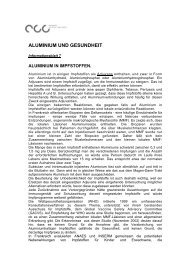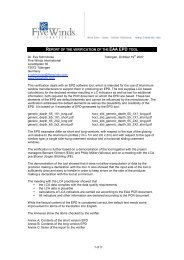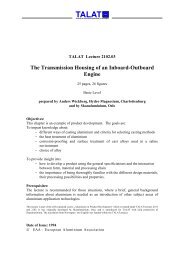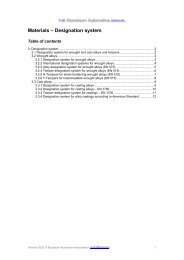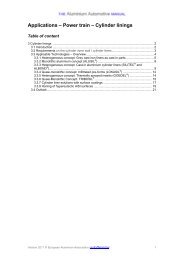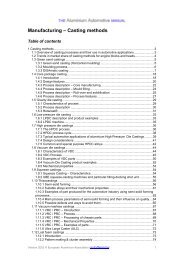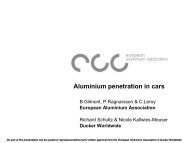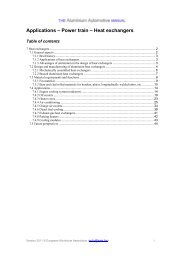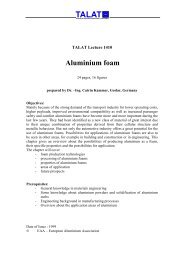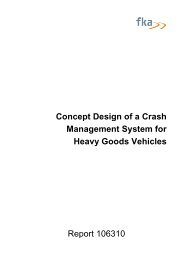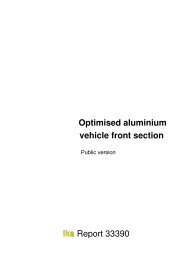aluminium in commercial vehicles - European Aluminium Association
aluminium in commercial vehicles - European Aluminium Association
aluminium in commercial vehicles - European Aluminium Association
You also want an ePaper? Increase the reach of your titles
YUMPU automatically turns print PDFs into web optimized ePapers that Google loves.
EUROPEAN ALUMINIUM ASSOCIATION ALUMINIUM IN COMMERCIAL VEHICLES CHAPTER IV 33<br />
2) A m<strong>in</strong>imum stiffness is generally<br />
required.<br />
• If this stiffness has to be equal<br />
with standard steel models,<br />
weight sav<strong>in</strong>gs obta<strong>in</strong>ed with<br />
<strong>alum<strong>in</strong>ium</strong> will be around 45%<br />
with a superior strength, but<br />
high strength steel cannot<br />
achieve any weight sav<strong>in</strong>g.<br />
• If the m<strong>in</strong>imum stiffness<br />
required is lower than the one of<br />
standard steel models, weight<br />
sav<strong>in</strong>gs obta<strong>in</strong>ed with <strong>alum<strong>in</strong>ium</strong><br />
will be somewhere between<br />
45% & 60% and weight sav<strong>in</strong>gs<br />
obta<strong>in</strong>ed with high strength<br />
steel somewhere between zero<br />
and half of what can be<br />
achieved with <strong>alum<strong>in</strong>ium</strong>.<br />
3) Vehicles durability must be<br />
<strong>in</strong>sured. As <strong>alum<strong>in</strong>ium</strong> <strong>vehicles</strong><br />
are much more <strong>in</strong>tensively used<br />
than conventional ones, their<br />
resistance to fatigue must be<br />
higher. This result is obta<strong>in</strong>ed<br />
with a proper design. Among of<br />
a lot of others, higher sections,<br />
smooth transitions and clever<br />
jo<strong>in</strong>ts are keys to success.<br />
Chassis for <strong>alum<strong>in</strong>ium</strong> tipper (Leciñena)<br />
2.2. Are there different <strong>alum<strong>in</strong>ium</strong> chassis designs?<br />
Each manufacturer has its own<br />
design, which to a high degree<br />
depends on the work<strong>in</strong>g conditions<br />
the vehicle is made for and<br />
on the specific manufactur<strong>in</strong>g<br />
experiences of the chassis producer<br />
(e.g. some prefer fully<br />
welded constructions whereas<br />
others prefer mixed welded and<br />
bolted constructions). It is also<br />
important to underl<strong>in</strong>e that <strong>alum<strong>in</strong>ium</strong><br />
<strong>vehicles</strong> are much more<br />
<strong>in</strong>tensively used than conventional<br />
ones, and this fact is<br />
taken <strong>in</strong>to account <strong>in</strong> the design<br />
of <strong>vehicles</strong>. Apart from that,<br />
there are two dom<strong>in</strong>at<strong>in</strong>g<br />
design philosophies <strong>in</strong> the chassis<br />
world.<br />
In countries like Italy, where<br />
equal stiffness with steel models<br />
seems to be a must, deflection is<br />
the ma<strong>in</strong> criteria, and this generally<br />
leads to longer lifetime than<br />
conventional models, coupled<br />
with an attractive weight sav<strong>in</strong>g.<br />
In other countries, equal lifetime<br />
with steel models will be the<br />
ma<strong>in</strong> criteria. A good design will<br />
lead to, at least, an equivalent<br />
lifetime, stiffness with<strong>in</strong> requirements<br />
(even though it may be<br />
slightly lower than steel models),<br />
but the weight sav<strong>in</strong>g will<br />
be maximized.<br />
In any case, they will usually be<br />
stronger than classic models,<br />
and the risk for start<strong>in</strong>g yield<br />
failure from static overload will<br />
be lower for <strong>alum<strong>in</strong>ium</strong> chassis.



